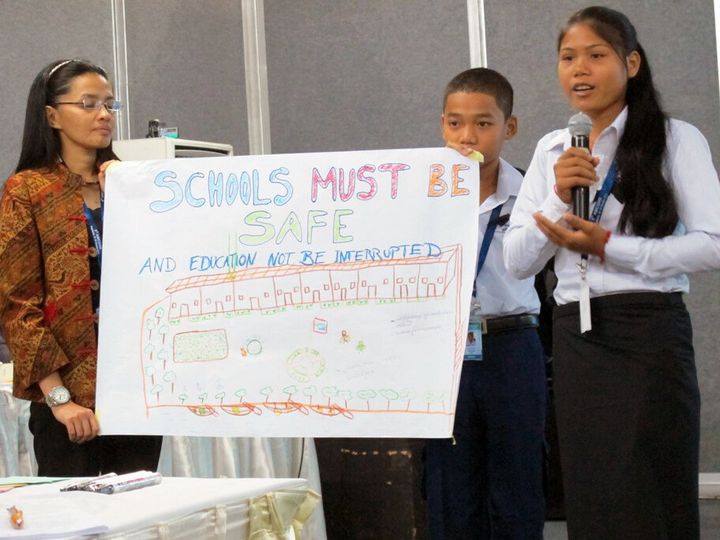
"Let us be a part of it," was the clear message coming from children taking part in a key Asian conference on disaster risk reduction (DRR) in Yogyakarta, Indonesia, this week. The young representatives have been making their voices heard, sharing their stories and emphasising the importance of involving children and youths in efforts to ensure communities are prepared for when disasters strike.
"I would like to appeal to governments, NGOs and other stakeholders to continue to encourage and listen to children's voices and accept children's activities on disaster risk reduction; to build the capacity of children and the community on how to reduce disaster risks; to share experiences and best practices on school-based disaster risk reduction with children," said 17-year-old Sopaoeurn from Cambodia.
"As children, I want to see that all schools in Cambodia and around the world are safe from disasters," she added.
Seventeen children from around the region have been offering up ideas and solutions to everyone from government ministers to the Queen of Yogyakarta, Ratu Hemas, and the UN's DRR chief, Margareta Wahlström.
No victims here
The discussions at the 5th Asian Ministerial Conference on Disaster Risk Reduction (AMCDRR), held every two years, have been fruitful and serve as a reminder that children aren't simply helpless victims, as they have so often been labelled.
This is the stereotype that we at Plan International are trying to break as part of the Children in Changing Climate coalition along with the likes of Save the Children and World Vision. Why should children have to sit on the sidelines while adults dictate how and when DRR is approached?
Disasters don't pick and choose whose lives they impact and so it's important not to pick and choose who is involved in preparedness activities. It was a wiser man than me who said, "Grown men can learn from very little children for the hearts of little children are pure. Therefore, the Great Spirit may show to them many things which older people miss."
Children in action
So how can children be a part of DRR? For starters, children can draw maps to analyse hazards and vulnerabilities in their communities. They can get involved in games, radio shows, drama performances and street campaigns to help raise awareness of disasters. They can take their newfound knowledge and pass it onto their friends, family and neighbours. They can be a part of disaster drills so they know exactly what to do during the real thing.
The list goes on, but the point is that when children are involved, they're anything but victims, as 9-year-old Gentha from Indonesia will tell you.
"I would like to tell all policy makers and adults: do not underestimate children. We are able to contribute to bringing change. We boys and girls are able to be involved actively in DRR," he said.
After four days of workshops and brainstorms, discussions and debates, the child participants presented their ideas to the delegates in the form of a statement to be added to the final declaration.
What we hope to come away from this with is a renewed sense of commitment from countries in Asia, the world's most disaster-prone continent, to prioritise children when implementing DRR measures. The next step will be to turn this commitment into action and then hopefully in two years time we'll be able to meet up in Thailand at the 6th AMCDRR with some solid achievements behind us.
For more information on what we're doing to support children's participation in DRR, follow Plan Asia on Twitter and Facebook, or check out our new publication, a collaboration with UN International Strategy for Disaster Reduction, featuring a collection of stories penned by children from around the region exploring how disasters have affected their lives and what they've been doing in response.